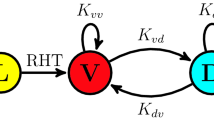Summary
Theoretical considerations of circadian rhythms have shown that, under conditions of a light-dark cycle, the duration of twilight has a twofold influence on phase-angle difference between an activity cycle and the Zeitgeber: 1. The longer the twilight periods, the earlier occurs the activity relative to the Zeitgeber, and 2. the longer the twilight periods, the stronger changes the phase-angle difference with changing L∶D-ratio. In former biological experiments, these predictions are confirmed only with very long twilight periods and only with light-active birds. In experiments described here, phase-angle difference between activity cycle and Zeitgeber are examined in light-active birds (finches) and in dark-active mammals (hamsters) under the influence of short twilight periods with varying duration. All results show a clear agreement between theory and experiment.
These results confirm the validity of the theory with stronger significance than any other biological experiment up to now, because the theoretical derivation of the twilight influence covers more essential aspects of the theory than the derivation of any other influence (e.g.: influence of L∶D-ratio). Furthermore, these results have consequences with regard to the seasonal change in phase-angle differences, because in nature not only the L∶D-ratio changes seasonally but also the duration of twilight. Especially in dark-active organisms, the twilight influence changes remarkably the seasonal course of phase-angle difference in comparison to that course derived only from the seasonal change in L∶D-ratio. Because of the prevailing twilight influence these phase-angle differences, as relevant for photoperiodic phenomena, take a similar course in light-active and in dark-active organisms.
Zusammenfassung
Theoretische Untersuchungen der circadianen Periodik mit Hilfe eines mathematischen Modells hatten zu der Voraussage geführt, daß die Phasenwinkel-Differenz zwischen einer Aktivitäts-Periodik und einem Licht-Dunkel-Zeitgeber in zweifacher Weise von der Dämmerungs-Dauer abhängt: 1. Je länger die Dämmerung, desto früher liegt die Aktivitäts-Periodik relativ zum Zeitgeber; 2. je länger die Dämmerung, desto stärker ändert sich die Phasenwinkel-Differenz zum Zeitgeber bei Variation des L∶D-Verhältnisses. In einer ersten Versuchsreihe waren diese Voraussagen für lange Dämmerungen und für licht-aktive Vögel bestätigt. In den hier beschriebenen Experimenten ist der Einfluß kurzer Dämmerungen verschiedener Dauer untersucht, und zwar bei licht-aktiven Finken-Vögeln und bei dunkel-aktiven Goldhamstern. Alle Ergebnisse stimmen mit den theoretischen Voraussagen überein.
Die Ergebnisse dieser Versuche sind für die Bestätigung der Theorie von besonderer Bedeutung, da in die Ableitung des Dämmerungs-Einflusses mehr wesentliche Eigenschaften der Theorie eingehen als in die Ableitung aller anderen bisher untersuchten Einflüsse (z.B. des Einflusses variabler L∶D-Verhältnisse). Die hier beschriebenen Ergebnisse sind außerdem von Bedeutung für die jahreszeitliche Änderung der Phasenlage, die die natürliche Grundlage für photoperiodische Prozesse bildet: In der Natur wechselt im Verlaufe der Jahreszeiten nicht nur das L∶D-Verhältnis, sondern auch die Dämmerungs-Dauer. Besonders bei dunkelaktiven Organismen ändert die Mit-Berücksichtigung des Dämmerungs-Einflusses entscheidend den alleine unter Berücksichtigung des L∶D-Verhältnisses abgeleiteten Jahresgang der Phasenlage und gleicht ihn dem für licht-aktive Organismen gültigen an.
Similar content being viewed by others
Literatur
Aschoff, J.: Messung der lokomotorischen Aktivität von Mäusen mittels mechanischer Gleichrichter. Pflügers Arch. ges. Physiol. 254, 262–266 (1951).
—: Exogenous and endogenous components in circadian rhythms. Cold Spr. Harb. Symp. quant. Biol. 25, 11–27 (1960).
—: Die Tagesperiodik licht- und dunkelaktiver Tiere. Rev. Suisse Zool. 71, 528–558 (1964).
Aschoff, J., u. R. Wever: Beginn und Ende der täglichen Aktivität freilebender Vögel. J. Ornith. 103, 2–27 (1962).
—: Circadian rhythms of finches in light-dark cycles with interposed twilights. Comp. Biochem. Physiol. 16, 507–514 (1965).
—: Circadian period and phase-angle difference in Chaffinches (Fringilla coelebs L.). Comp. Biochem. Physiol. 18, 397–404 (1966).
Bünnig, E.: Die physiologische Uhr. Berlin-Göttingen-Heidelberg: Springer 1963.
Wever, R.: Ein mathematisches Modell für biologische Schwingungen. Z. Tierpsychol. 21, 359–372 (1964a).
—: Zum Mechanismus der biologischen 24-Std-Periodik. III. Mitteilung. Anwendung der Modell-Gleichung. Kybernetik 2, 127–144 (1964b).
—: A mathematical model for circadian rhythms. In: Circadian clocks (ed. J. Aschoff), p. 47–63. Amsterdam: North-Holland Publ. Comp. 1965.
- Ein mathematisches Modell für die circadiane Periodik. Z. angew. Math. Mech. (im Druck) (1967a).
—: Gesetzmäßigkeiten circadianer Aktivitäts-Rhythmen bei Tier und Mensch. In: Distributions temporelles des activités animales et humaines (ed. J. Médioni). Paris: Masson & Cie. 1967b (im Druck).
Author information
Authors and Affiliations
Additional information
The research reportet in this document has been sponsored in part by the Air Force Office of Scientific Research under grant AF EOAR 66-15, with the European Office of Aerospace Research (OAR), United States Air Force.
Rights and permissions
About this article
Cite this article
Wever, R. Zum Einfluß der Dämmerung auf die circadiane Periodik. Zeitschrift für vergleichende Physiologie 55, 255–277 (1967). https://doi.org/10.1007/BF00349602
Received:
Issue Date:
DOI: https://doi.org/10.1007/BF00349602




